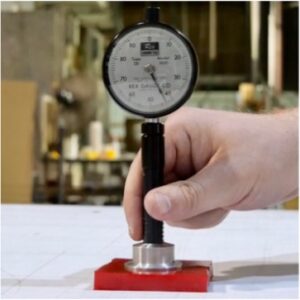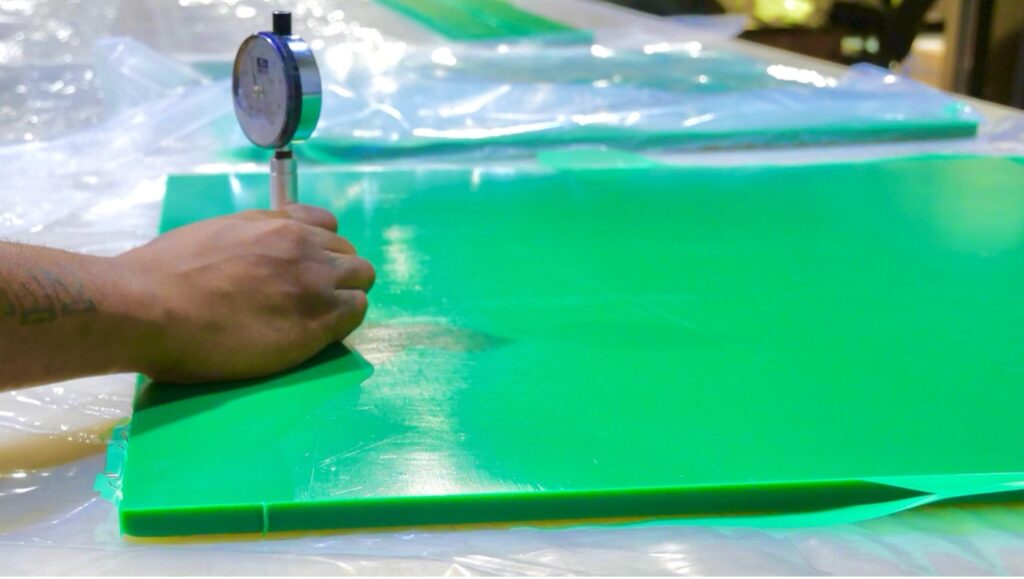The Shore Hardness scale is supposed to be a useful tool for understanding the properties of a material. However, there is some confusion surrounding the term, what all it entails, and how it applies to materials like the ones we work with here at PSI Urethanes. Today we’re here to clear the air surrounding this mystifying metric and share everything we know to help you gain a better understanding of The Shore Hardness Scale.
How The Shore Hardness Scale Works
The Shore Hardness Scale is a system designed to indicate the hardness or softness of a material, generally those that fall into the categories of polymers or elastomers. That overall hardness is referred to as a durometer- a term we’ll be taking a closer look at later in this article. What you need to know now is that there are two components of a material’s durometer, or hardness. To provide an example, the durometer specification of a very hard material may look something like this:
70 Shore D
There are two major components to understanding a reading on The Shore Hardness scale: the leading number, and the following letter designation.
The number can be any value from 0 to 100. A lower number indicates a softer material, while a higher number indicates a harder material. This part of the specification is fairly straightforward- but the following letter designation can be a bit more complex.
The letter used in a durometer reading indicates the overall hardness group, or durometer type, that the material falls into. Although commonly referred to as The Shore Hardness Scale, there are actually several scales that fall within the larger umbrella term. These durometer types are grouped together by their relative softness or hardness. The most common durometer types that are used in the polymer manufacturing world are Shore A and Shore D; however, there are 12 different shore scales in total, each with their own intended use. We will not be going into every single scale today, just the ones that are most relevant to the shore hardness of polyurethane: Shore OO, Shore A, and Shore D.
Shore OO Hardness Scale
The Shore OO hardness scale is used for measuring the softest available formulations that we offer here at PSI Urethanes. Materials that fall into the Shore OO hardness scale are generally softer than a rubber band. As a result, they are best suited to applications that call for high shock absorption or dissipation. They also make an excellent choice for low pressure seals and gaskets. Our patented DrainProtector™ II falls on this scale with a measurement of 40 Shore OO.
Shore A Hardness Scale
The Shore A Hardness Scale encompasses the broadest range of durometers, including those as soft as a rubber band up to those as hard as a shopping cart wheel. As a result, the Shore A Scale is the most commonly used out of the three mentioned in this article. Many urethane formulations fall within this scale, as Shore A materials offer a great balance between durability and flexibility. On the lower end, Shore A materials can be used for applications like robotic grippers. On the higher end of the Shore A scale, you can find industrial grade components like rollers and wheels for conveyor systems.
Shore D Hardness Scale
The last scale that we commonly work with is the Shore D Hardness Scale. Materials that fall under this classification include extremely rigid polymers with little flexibility. These polymers also have a very low coefficient of friction. While they are not well suited to applications that require any degree of grip, they excel in providing impact resistance. This makes them a popular choice in heavy duty industrial applications; for example, Shore D urethanes are highly favored in the metal forming industry.
Whether you need a material as soft as a gel shoe insole or as tough as nails, PSI Urethanes can formulate the ideal urethane for you.
Get Started
Durometer Defined
Simply put, the term “Durometer” is just another word used to describe the hardness or softness of an elastomeric material. We use the term durometer specifically when discussing the hardness of a material within the context of the shore hardness scale. Since the hardness of urethane materials are measured on the shore hardness scale, we refer to it as the urethane’s durometer rather than the urethane’s hardness. When a material is referred to as low durometer, that means it is soft; and more rigid materials are referred to as high durometer.
How Is Durometer Measured?
 Durometer is measured using a tool called a durometer gauge. The way it works is that the tip of the gauge is pressed directly into the material being measured. The resulting resistance applied to the tip is what’s measured by the gauge. The gauge then displays the number portion of the durometer on an LED display, LCD display, or a good old fashioned dial.
Durometer is measured using a tool called a durometer gauge. The way it works is that the tip of the gauge is pressed directly into the material being measured. The resulting resistance applied to the tip is what’s measured by the gauge. The gauge then displays the number portion of the durometer on an LED display, LCD display, or a good old fashioned dial.
Generally speaking, there are different durometer gauges for each durometer type. There are some gauges which can measure a range of durometer types; it’s not uncommon to see one that can measure both Shore A and Shore D durometers. However, different durometer types are measured with different tips, so always be sure to use the proper gauge for your durometer type to get an accurate reading.
We work with the widest range of durometers from Shore OO to Shore D. If you need the best of both worlds, ask about our custom dual durometer formulations.
Contact Us
What The Shore Hardness of Polyurethane Means
Understanding how the shore hardness scale applies to urethane materials is integral to selecting the right formula for a given application. Polyurethane is a highly versatile material with properties that can be altered through careful formula development (a practice that we’ve perfected here at PSI Urethanes). The shore hardness of polyurethane is just one of many of these properties which can be adjusted through custom formulations. Although it is technically just a single property amongst a sea of many, the other properties of a urethane material can often be inferred based on whether it is a low durometer or high durometer polyurethane.
Low Durometer Polyurethanes
Polyurethanes that fall on the lower end of the shore hardness scale generally share the following properties:
- High grip (high coefficient of friction)
- High flexibility
- Low impact resistance
High Durometer Polyurethanes
Conversely, urethanes on the higher end of the scale share these properties:
- Low grip (low coefficient of friction)
- High rigidity
- Excellent impact resistance



